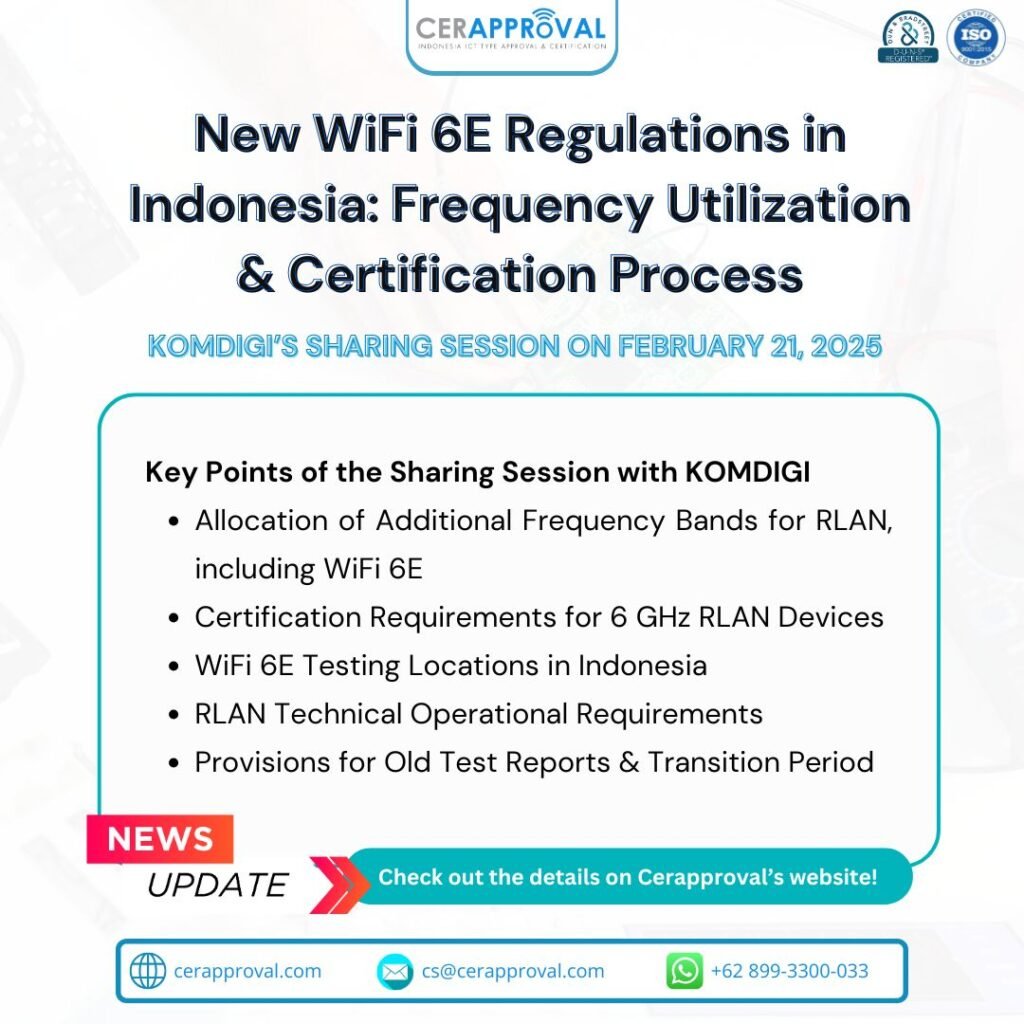
In 2025, Indonesia adopted new regulations regarding the use of additional frequency bands for Radio Local Area Network (RLAN) technology, including WiFi 6E (IEEE 802.11ax). These regulations are outlined in Ministerial Regulation of Communication and Digital No. 2 of 2025 and Ministerial Decree of Communication and Digital No. 12 of 2025.
Designation of Additional Frequency Bands for RLAN
Indonesia has now designated the 5925-6452 MHz band for RLAN technology, including WiFi 6E. The regulations are detailed in PM No. 2/2025, with key points as follows:
- The additional frequency band for RLAN has been designated within the 5925-6452 MHz range.
- The technical standard regulations for RLAN 6 GHz (5925-6425 MHz) are outlined in KM No. 12/2025.
| No. | Radio Frequency Spectrum | Maximum Transmit Power Usage (Effective Isotropic Radiated Power – EIRP) | Maximum Bandwidth per Radio Frequency Channel | Device Placement |
|---|---|---|---|---|
| 6. | 5925–6425 MHz | Access Type 1: Low Power Indoor (LPI) 200 mW (23 dBm) Access Type 1: Very Low Power (VLP) 25 mW (14 dBm) | 320 MHz | Indoor use only; placement outdoors is prohibited Indoors and outdoors use |
Certification Requirements for RLAN 6 GHz Devices
To obtain certification in Indonesia, RLAN 6 GHz devices must meet the following requirements:
Test Report (LHU) Acceptance:
- Curently, only Test Reports issued by local testing laboratories (BBPPT) are accepted.
- Foreign Test reports originated from MRA laboratories with a recognized scope for RLAN 6 GHz testing.
Additional Documents:
- A declaration letter specifying the device type (Low Power Indoor or Very Low Power).
- A declaration letter regarding power supply and antenna gain, if not included in the Test Report (LHU).
- A declaration letter regarding the interface of the telecommunications device for RLAN, if not included in the test reports / LHU.
- A declaration letter answering specific questions related to software/firmware, as outlined in Annex V of the Ministerial Decree.
Additional Provisions:
- For test results on test reports of access points, routers, and similar devices, changing the country of origin lock settings is prohibited. The device location must be locked to Indonesia.
- Test Reports (both local and foreign) must only include frequency measurement results within the allowed frequency range allocated in Indonesia.
WiFi 6E Testing Process in Indonesia
Currently, WiFi 6E (RLAN 6 GHz) testing can only be conducted locally at BBPPT Indonesia. Foreign Test Reports will only be accepted if they originate from an MRA laboratory with an approved scope for RLAN 6 GHz.
Technical Operational Requirements
| Frequency Range | Technical Operational Requirements |
|---|---|
| Access Type 1: RLAN 5150-5250 MHz | – Must be placed indoors – Not allowed to be placed outdoors |
| Access Type 1: RLAN 5250-5350 MHz | – Must be placed indoors |
| Access Type 1: RLAN 2400-2483.5 MHz 5725-5825 MHz | – Must be placed indoors |
| Access Type 2 and Backhaul 2400-2483.5 MHz 5725-5825 MHz | – Not allowed to be placed outdoors |
| RLAN 5925-6425 MHz Low Power Indoor (LPI) | – Must be placed indoors – Not allowed to be placed outdoors – Cannot be used for drones – Cannot be installed in vehicles, trains, boats, or airplanes – AP devices must be powered by AC, DC, or PoE cable connection. Battery use is not allowed – Client devices must be powered by AC or battery and can only operate under the control of an AP |
| RLAN 5925-6425 MHz Very Low Power (VLP) | – Can be placed indoors – Can be placed outdoors – Can be used in tethering mode – Cannot be used for drones – Must be powered by battery (DC). AC power is only allowed for battery charging |
| RLAN 57-64 GHz | – Must be placed indoors – Not allowed to be placed outdoors |
Old Test Report Regulations & Transition Period
Test Report issued before January 15, 2025, referencing Director General Regulation No. 2/2019, can still be used for certification under Director General Regulation SDPPI No. 2/2019 until July 15, 2025 and must include supplementary test reports with updated test parameters.
If you need further assistance with the SDPPI/Postel certification process for RLAN 6 GHz devices, Cerapproval is ready to help ensure your devices comply with the applicable regulations.
📧 Contact Us: gma@cerapproval.com
